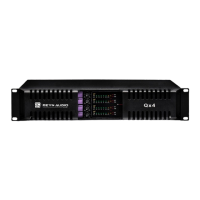
Do you have a question about the Reyn Audio QX4 series and is the answer not in the manual?
| Amplifier Class | Class D |
|---|---|
| Number of Channels | 4 |
| Frequency Response | 20Hz - 20kHz (±0.5dB) |
| Damping Factor | >200 |
| Cooling | Convection cooling with temperature-controlled fan |
| Weight | 8.5kg |
| Input Impedance | 20 kΩ balanced |
| Power Supply | 90-260 V (50/60 Hz) |
| Dimensions (H x W x D) | 88mm x 483mm x 380mm |
| Input Sensitivity | 1.4V for full output |
Explains graphical symbols used in the manual for warnings and cautions.
Lists crucial safety instructions for operating the amplifier.
Outlines user responsibilities regarding grounding, hazards, and maintenance.
Declares the presence of restricted substances according to marking regulations.
Introduces the Qx4 amplifier and the manual's purpose.
Highlights the key technologies and capabilities of the Qx4 amplifier.
Provides instructions for safely unpacking the amplifier and checking for damage.
Details how to mount the amplifier, including using rear support brackets.
Explains the amplifier's cooling system and airflow requirements.
Specifies operating voltage requirements and connection instructions.
Discusses grounding requirements and safety considerations for the amplifier.
Describes the front panel layout, indicators, and controls of the amplifier.
Details the rear panel layout, connectors, and configuration options.
Explains the procedure for hot-plugging the amplifier modules.
Introduces the sections covering amplifier connection, setup, operation, and performance.
Lists essential precautions to take before and during amplifier operation.
Explains the signal flow within the amplifier and the concept of headroom.
Illustrates the signal flow path through the amplifier's internal stages.
Details how headroom, sensitivity, VPL, and gain settings interact.
Covers balanced and unbalanced input connections and Speakon output connections.
Explains how to wire balanced XLR input connectors for optimal signal integrity.
Describes methods for connecting unbalanced sources to XLR inputs.
Details the Speakon output connectors and their wiring for speakers.
Explains how to configure the amplifier for bridged mono operation.
Covers adjustable input gain settings and how they affect sensitivity.
Describes adjusting individual channel gain using front-panel potentiometers.
Defines amplifier sensitivity and its relation to output power.
Explains the Voltage Peak Limiter (VPL) feature for setting maximum output voltage.
Details the Current Peak Limiter (CPL) for preventing over-current conditions.
Covers the amplifier's protection features, fault indicators, and warnings.
Introduces the amplifier's protection and fault monitoring features.
Explains the SOAD feature for monitoring output transistor operation.
Describes the VHF protection circuit that prevents damage from high frequencies.
Details DC protection to prevent loudspeaker damage from DC output.
Explains the high-impedance warning for open speaker loads.
Describes low-impedance protection against short circuits.
Covers thermal protection that mutes channels when overheating occurs.
Explains the PAL feature that limits power consumption to prevent PSU overload.
Details the soft-start feature to manage inrush current upon power-up.
Describes how to monitor amplifier status and adjust settings via the front panel.
Explains the function of the front panel LED indicators for signal and status.
Details how to adjust channel levels using the front-panel potentiometers.
Explains how mute status is indicated on the front panel.
Describes the meaning of various performance, warning, and fault indicators.
Details the patented AMP module and its hot-plug functionality.
Provides instructions for routine maintenance of the amplifier.